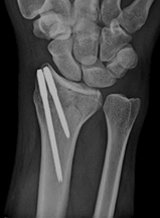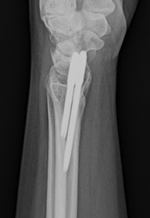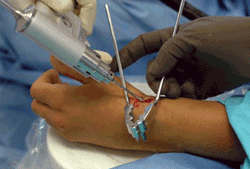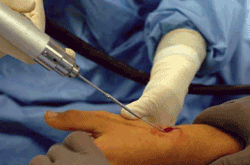Stable distal radius fracture fixation possible with threaded pinning method
With this method, fractured wrists typically reached over 90% normal motion by 1 year postop.
A new distal radius fracture fixation technique developed to reduce the malunion rate that often accompanies traditional cast immobilization fixation effectively restored 60% to 80% of wrist arc of motion by 3 months and over 90% of normal motion by 1 year postoperatively, according to the surgeon who developed the technique.
The less-invasive pinning technique achieved stability of distal radius fractures, including comminuted ones, according to developer John S. Taras, MD, of Philadelphia.
The technique typically involves two threaded variable-length cannulated T-Pins (Union Surgical), which act like a screw to gain good purchase of the bone and fix the fragments. The T-Pin is a more stable alternative to the smooth pins hand surgeons usually place in various configurations to treat these fractures, Taras said.
Imaging helpful
|
|
“This is done through small incisions with visualization of the bone to protect against damage or irritation to the radial sensory nerve or adjacent tendons,” Taras said in describing his surgical technique at a symposium on distal radius fractures at the American Academy of Orthopaedic Surgeons annual meeting.
“Fluoroscopy imaging is really essential to do this technique,” he said, noting the importance of protecting the tissue in the area and avoiding extensor pollicis longus (EPL) ruptures and other complications.
Advantages of the new fixation approach include the ability to perform the technique under local anesthesia, insertion of the pins over guide wires for accuracy, and the fact that the driver portion of the pin easily breaks away manually, precluding the need to use other tools or disturbance of the implant once it is in place, Taras said.
Early range of motion
Among the 71 distal radius fractures Taras treated with the technique, three complications occurred by the 1-year follow-up, including one loss of reduction, an EPL rupture and a case of reflex sympathetic dystrophy.
“The early range of motion restoration was good,” he said.
By 1 year postoperative, the restored arc of motion in most of the wrists Taras treated reached over 90% of preoperative motion.
|
|
Images: Taras JS |
Maintains reduction
In addition, “The reduction achieved in the operating room was preserved within the acceptable parameters,” Taras said.
Fracture reductions performed in the emergency room had 11° to 12° dorsal angulation with -1 mm ulnar variance. After treatment these parameters measured 5° volar of tilt and +0.7 mm of ulnar variance.
The technique utilizing two pins placed through the radial styloid is also indicated for moderately comminuted fractures, but for more severely comminuted fractures or those in osteoporotic patients Taras has successfully implanted two T-Pins using a cross-pin technique.
|
|
|
Effective option
Although level 1 and level 2 clinical studies have not been conducted into the T-Pin fixation method, Taras found it provides an effective option that is associated with less surgical trauma and permits patients to move their wrists earlier.
Therapy is initiated under the guidance of a hand therapist for active and passive digital range of motion, edema control and gentle wrist active range of motion at the first postoperative visit.
“Restoring range of motion, because there is not a lot of surgical trauma, can proceed relatively quickly, but will vary based on patients’ response to the fracture,” he said.
Pins can stay in or come out. Taras said he has left most of them in place without any problems.
For more information:John S. Taras, MD, can be reached at The Philadelphia and South Jersey Hand Centers, 834 Chestnut St., Suite G114, Philadelphia, PA 19107; 215-521-3004; e-mail: jstaras@handcenters.com. He receives payments for presentations from Integra Life Sciences, research or institutional support from Axogen and was a founder of Union Surgical.
- Reference:
Taras JS. New fixation options. Symposium L: Distal radius fractures: new concepts in treatment. Presented at the American Academy of Orthopaedic Surgeons 76th Annual Meeting. Feb. 25-28, 2009. Las Vegas.





